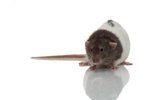
Wild rats, who live in colonies, and pet rats, who enjoy the company of other rats, are naturally social creatures. They are happier and more playful when kept in same gender pairs or groups, or in communities made up of spayed and neutered rats of both genders. Rats like being with people, and people appreciate the affectionate, adventurous, curious and intelligent nature of these little creatures. Each rat has a unique personality, along with individual likes and dislikes, which are expressed in a variety of ways.
Physical Communication
Rats have numerous ways of communicating with each other, the most common being body language. When rats become socially mature at around five months old, the males may behave more aggressively toward each other. Rats are hierarchical, and the more dominant rat eventually achieves alpha status. Even bonded rats might escalate from harmless play fighting into more serious battles. These physical behaviors are natural for rats and are used to communicate with each other and to establish their place in the community.
Meeting Strangers
When introducing rats who do not know each other, you might notice them puffing up their fur, fighting, pinning each other down, pushing each other onto their backs, humping, grooming and squeaking. Unless their dislike for each other does not abate, rats will eventually become friends after a slow, careful introduction. Their behaviors express that their relationship is evolving into something more positive. Rats thrive on social activity and benefit from stimulation provided by the company of other rats. They spend time eating, building nests and sleeping together, as well as play fighting and grooming each other.
Hearing and Sounds
Rats have excellent hearing, and they communicate with each other by producing and recognizing meaningful ultrasound frequencies that humans cannot hear. To people, rats seem very quiet, emitting an occasional squeak that is audible. When rats vocalize at a frequency humans can hear, the rat may be stressed or frightened and is using sound to protest discomfort or express pain. Some rats will squeak or grunt to talk to their humans.
Expressing Happiness

Rats may grind their teeth when stressed or in pain, but tooth-grinding is typically a rat's way of expressing contentment and relaxation. This behavior is known as bruxing. Another way rats communicate happiness is by eye boggling, which is when a rat's eyes vibrate rapidly in and out of the eye socket. If you notice your rat simultaneously bruxing and eye boggling, she is telling you that she is very happy.
Urine Marking
Wild and tame rats mark with their urine to communicate with other rats and animals in their environment. One rat's urine gives other rats information that helps identify his species, age, gender, place in the social hierarchy and reproductive status. Marking helps rats determine where they are, and by following the scent trails they have left through the environment, rats can discover where they have been and what path to take to return to their safe home.
Grooming
Mothers groom baby rats as a way to bond and as part of maternal care. Rats groom each other as a form of social interaction and friendship. Petting your rat and stroking her on the face and neck imitates social grooming activity, and your rat reciprocates by grooming you. Rats groom their people by licking or nibbling them, which can be interpreted as bonding behavior, recognizing you as a family member and expressing affection. However, when some rats are scared or if you hold them too tightly, they will tell you to stop or let go by licking or nibbling, rather than biting you.
References
Photo Credits
-
Jupiterimages/Photos.com/Getty Images
Writer Bio
Maura Wolf's published online articles focus on women, children, parenting, non-traditional families, companion animals and mental health. A licensed psychotherapist since 2000, Wolf counsels individuals struggling with depression, anxiety, body image, parenting, aging and LGBTQ issues. Wolf has two Master of Arts degrees: in English, from San Francisco State University and in clinical psychology, from New College.




